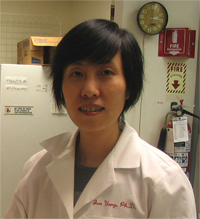
Jun Yang, PhD
Assistant Professor of Ophthalmology and Visual Science, The University of Utah, John A. Moran Eye Center
Research: “Formation and Function(s) of the Usher 2 Protein Complex in Photoreceptors”
Research
Pathogenetic mechanisms of retinal degeneration and cell biology of photoreceptors.
Retinal degeneration is mainly caused by photoreceptor cell death and retinal pigment epithelium malfunction. It generally includes retinitis pigmentosa and macular degeneration. Although many genes have been identified as responsible for these diseases, their physiological functions and pathogenic mechanisms are not clear. Additionally, many causative genes are still unidentified.
The research in Dr. Yang’s laboratory is focused on the disease mechanisms and therapeutic treatments for retinal degenerative diseases using mouse models. Her research group investigates the biological functions of genes whose mutations are known to cause human retinal diseases. Using mouse models for these diseases, the group also studies how to treat these diseases by means of gene therapy. Dr.Yang’s team is also interested in cell biology of photoreceptors, especially the cellular processes of intracellular trafficking, structural maintenance, and calcium regulation.
The ongoing research projects in her laboratory are to understand three things: 1. how defects in the multiple protein complex at the periciliary ridge complex in photoreceptors cause retinal degeneration in Usher Syndrome type II, which is a disease with both vision and hearing loss; 2. the biological functions of the ciliary rootlet, a cytoskeletal structure, in photoreceptors and how its defects cause retinal degeneration; 3. how calcium homeostasis is maintained in photoreceptor synaptic terminals and whether it is involved in retinal degeneration.
Publications
Yang, J., Pawlyk, B., Wen, X., Adamian, M., Soloviev, M., Michaud, N., Zhao, Y., Sandberg,, M.A., Makino, C.L., and Li, T. (2007) Mpp4 is required for proper localization of plasma membrane calcium ATPases and maintenance of calcium homeostasis at the rod photoreceptor synaptic terminals. Human Molecular Genetics, 16:1017-1029.
Yang, J., and Li, T. (2006) Rootletin. Experimental Eye Research, 83:1-2.
Yang, J., Adamian, M., and Li, T. (2006) Rootletin interacts with C-Nap1 and may function as a physical linker between the pair of centrioles/basal bodies in cells. Molecular Biology of the Cell, 17:1033-1040.
Yang, J., and Li, T. (2005) The ciliary rootlet interacts with kinesin light chains and may provide a scaffold for kinesin-1 vesicular cargos. Experimental Cell Research, 309:379-389.
Yang, J., Gao, J., Adamian, M., Wen, X., Pawlyk, B., Zhang, L., Sanderson, M.J., Zuo, J., Makino, C.L., and Li, T. (2005) The ciliary rootlet maintains long-term stability of the sensory cilia. Molecular and Cellular Biology, 25:4129-4137.
Yang, J., Liu, X., Yue, G., Adamian, M., Bulgakov, O., and Li, T. (2002) Rootletin, a novel coiled-coil protein, is a structural component of the ciliary rootlet. Journal of Cell Biology, 159:431-440.
